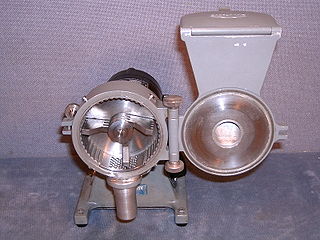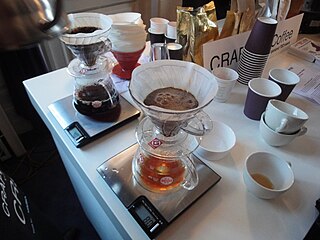
Metalworking is the process of working with metals to create individual parts, assemblies, or large-scale structures. The term covers a wide range of work from large ships and bridges to precise engine parts and delicate jewelry. It therefore includes a correspondingly wide range of skills, processes, and tools.

A meat grinder is a kitchen appliance for fine chopping ('mincing') and/or mixing of raw or cooked meat, fish, vegetables or similar food. It replaces tools like the mincing knife, for example, which is also used to produce minced meat, filling, etc. The producer puts the minced food into a funnel, which is placed on the top of the grinder. From there the material goes on a horizontal screw conveyor. This screw conveyor, which can be powered by a hand wheel or an electric motor, squashes and partially mixes the food. At the end of the screw conveyor there is a knife installed directly in front of the fixed hole plate. At this opening the minced meat comes out of the machine. The fineness of the meat depends on the size of the holes of the plate.

A mill is a device that breaks solid materials into smaller pieces by grinding, crushing, or cutting. Such comminution is an important unit operation in many processes. There are many different types of mills and many types of materials processed in them. Historically mills were powered by hand, working animal, wind (windmill) or water (watermill). Today they are usually powered by electricity.

A grinding machine, often shortened to grinder, is any of various power tools or machine tools used for grinding, which is a type of machining using an abrasive wheel as the cutting tool. Each grain of abrasive on the wheel's surface cuts a small chip from the workpiece via shear deformation.

An angle grinder, also known as a side grinder or disc grinder, is a handheld power tool used for grinding and polishing. Although developed originally as tools for rigid abrasive discs, the availability of an interchangeable power source has encouraged their use with a wide variety of cutters and attachments.

A grinding wheel is a wheel composed of an abrasive compound and used for various grinding and abrasive machining operations. Such wheels are used in grinding machines.

A burr mill, or burr grinder, is a mill used to grind hard, small food products between two revolving abrasive surfaces separated by a distance usually set by the user. When the two surfaces are set far apart, the resulting ground material is coarser, and when the two surfaces are set closer together, the resulting ground material is finer and smaller. Often, the device includes a revolving screw that pushes the food through. It may be powered electrically or manually.
Grind, grinder, or grinding may refer to:

Coffee preparation is the process of turning coffee beans into a beverage. While the particular steps vary with the type of coffee and with the raw materials, the process includes four basic steps: raw coffee beans must be roasted, the roasted coffee beans must then be ground, the ground coffee must then be mixed with hot water for a certain time (brewed), and finally the liquid coffee must be separated from the used grounds.

A jig grinder is a machine tool used for grinding complex shapes and holes where the highest degrees of accuracy and finish are required.

Die grinders and rotary tools are handheld power tools used for grinding, sanding, honing, polishing, or machining material. All such tools are conceptually similar, with no bright dividing line between die grinders and rotary tools, although the die grinder name tends to be used for pneumatically driven heavy-duty versions whereas the rotary tool name tends to be used for electric lighter-duty versions. Flexible shaft drive versions also exist. The die grinder name comes from one of their earliest and archetypal applications, tool and die work, where they were used to create the precise contours of dies or molds. Especially before the advent of widespread CNC usage, they were heavily relied upon for contouring via manual skill comparable to a sculptor's. CNC now provides much of the contouring for die and mold interior surfaces, but die grinders are still very useful for hundreds of cutting needs, from sculpture-like contouring in the absence of CNC, to cut-off of bar stock, to any of the cutting and grinding needs of fabrication, such as in the work of welders, boilermakers, millwrights, ironworkers, sheet metal workers, to woodworking, hacking, and other hobby or business pursuits. Die grinders are often used for engraving, cylinder head porting, and general shaping of a part.

The cylindrical grinder is a type of grinding machine used to shape the outside of an object. The cylindrical grinder can work on a variety of shapes, however the object must have a central axis of rotation. This includes but is not limited to such shapes as a cylinder, an ellipse, a cam, or a crankshaft.

Centerless grinding is a machining process that uses abrasive cutting to remove material from a workpiece. Centerless grinding differs from centered grinding operations in that no spindle or fixture is used to locate and secure the workpiece; the workpiece is secured between two rotary grinding wheels, and the speed of their rotation relative to each other determines the rate at which material is removed from the workpiece.

Grinding is an abrasive machining process that uses a grinding wheel as the cutting tool.

Honing is an abrasive machining process that produces a precision surface on a metal workpiece by scrubbing an abrasive stone against it along a controlled path. Honing is primarily used to improve the geometric form of a surface, but may also improve the surface texture.
A concrete grinder can come in many configurations, the most common being a hand-held Angle grinder, but it may be a specialized tool for countertops or worktops. There are also purpose-built floor grinders that are used for grinding and polishing marble, granite and concrete. Machines that grind concrete floors are usually made to handle much more stress and will have more power to drive the unit as concrete has a much higher sliding friction than marble or granite which is also worked wet, therefore with less friction. In fact some types of marble will spark when it is ground dry, causing deep damage to the marble surface.
Surface grinding is used to produce a smooth finish on flat surfaces. It is a widely used abrasive machining process in which a spinning wheel covered in rough particles cuts chips of metallic or nonmetallic substance from a workpiece, making a face of it flat or smooth.

A blade grinder, also known as propeller grinder, is a machine that chops material while mixing it, by means of a high-speed spinning blade. Applications of blade grinders for preparing foods include numerous electric kitchen appliances such as blenders, food processors, some garbage disposals, and some coffee grinders. The terms "blade grinder" and "propeller grinder" are in popular use to distinguish the blade grinder type of coffee grinder from other types. Other consumer applications include rotary lawn mowers.
















